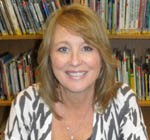Danna Smith attributes her love of words to her grandparents. Her grandmother wrote poetry and owned a clunky typewriter that the young Smith adored. “She allowed me to type on it. I started writing as soon as I could read,” Smith says. “I thought it was a dream come true because I’m a nerd.” Her grandfather owned a special pen that he kept in the pocket of his shirt. “I was the only [grandchild] who could use it because he knew how much I loved writing.” Smith’s uncle gave her an ear for rhyme as she bounced on his knee listening to his funny impromptu rhyming stories.
Two particular mentors later guided Smith along her path to becoming a published professional. “Thank goodness for teachers,” Smith says, because a high school creative writing teacher recognized her talent and encouraged it. Years went by while Smith attended college and started a family before she became serious about writing again. An established picture book author Rick Walton asked her to join his writer’s group after reading one of her manuscripts. “He said to me, ‘You may not be published now, but you will be soon.’ I will never forget that,” she says.
Smith specializes in picture books for preschool children, employing rhyming couplets to tell her fiction and nonfiction stories. She strives for repetition and an interactive concept that will allow children to participate in the telling. “Brevity is [also] a huge component,” Smith says. Her stories weigh in at less than 300 words or about one and one half double-spaced typed pages. Touchstone books she uses as models include Greg Foley’s Don’t Worry, Bear, David Martin’s We’ve All Got Bellybuttons, Mary Murphy’s I Kissed the Baby, and Eve Bunting’s retelling of Hey Diddle, Diddle.
Long walks and word play are integral to Smith’s creative process. “I am not a morning person,” she says, “but after a long walk or a hike I am filled with creative energy.” Many story ideas begin as titles, which in turn, come from a word twisting game she plays with herself. Treasure map morphed into treasure nap—the initial seed for Pirate Nap: A Book of Colors. Similarly, she manipulated Follow the Leader into Swallow the Leader, the title of her underwater counting book to be released in 2014.
According to Smith, the biggest misconception about writing for children is, “if it’s easy to read, it must be easy to write.” Before sitting down to the computer, Smith usually knows the title and the ending of a new story, but sometimes she has holes to plug. She constructs her plot first, and then bounces rhyming couplets around in her head in an imitation of her uncle’s rhyming process. “I do it everywhere I go, in fact people think I’m not paying attention to what they’re saying,” she says with a laugh. “It’s important to make the rhyme fit the story, rather than manipulating the story to fit the rhyme.” Smith’s standard requires her to be very choosy when selecting the 300 words that make the cut.
As Smith revises, she adds layers to her stories. “I think it’s important to have layers in a picture book because it appeals to many more people,” she says. Two at the Zoo started as a zoo story, but first expanded to include counting, and finally relationships with the addition of the main character’s grandfather.
Occasionally a story idea arrives like a surprise gift. The first two lines of A Wild Cowboy came to her in a dream. Her newest nonfiction title, Balloon Trees about where balloons come from, seemed a logical choice because her husband works in the rubber industry. After visiting Malaysia he told Smith about the extraction process. “The fact that they can take that rubber from trees and create so many products that we use every day is fascinating,” she says, “and so I wanted to share it with kids, but I had to find a way to present [the process] accurately and in a fun way.”
Most authors want their books to resonate with their readers, and Smith is no exception. Unfortunately, her readers are usually too young to dash off an email or connect on Facebook and Twitter. On one lucky day, however, Smith happened to be at the library near her Lodi home when she heard a child in full meltdown. “I looked up to see what was wrong. She had my book clutched to her chest. It was time to return the book and she wasn’t having it. Her mother was saying, ‘We’ve already checked it out four times. We’ll get another book.’ That was the ultimate fan letter for me. That’s why I write because I touched somebody’s life with this book.”
Smith believes in the importance of introducing authors to students during author visits. She discusses her writing process, plays literacy games, and responds to student questions about writing. “I never met an author when I was a kid,” Smith says. During one such school visit one little boy spied Smith standing at the front of the room. He turned to his friend and said, “Hey, she looks just like a real person.” In one short statement, he summed up Smith’s reason for visiting the school: “I’m just a regular person who happens to love words and books.”


